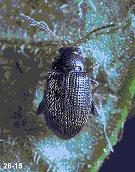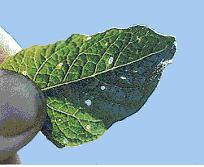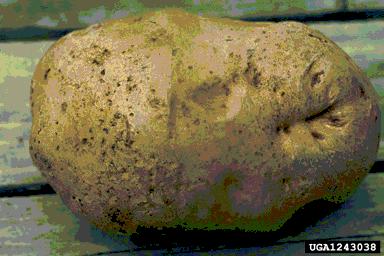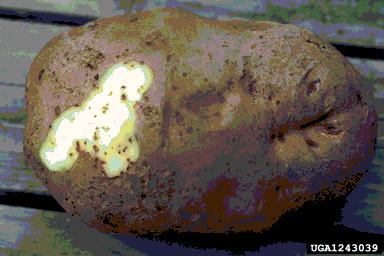| | What are Flea Beetles?
Flea beetle adults (Epitrix) are small (up to 2mm long), black beetles that jump when disturbed. Three different species have been found in Alberta (E. cucumeris, E. subcrinata, E. tuberis), however only Epitrix tuberis is known to cause serious damage to tubers. Adults feed on potato foliage, resulting in leaves with a characteristic "shot hole" appearance. Flea beetles are more frequently found on the underside of leaves. Damage is not usually economically significant, however high populations can defoliate and kill young plants.

Flea Beetle adult
© 2000. Ralph E. Berry, Department of Entomology,
Oregon State Univ., Corvallis, OR. |

"Shot hole" feeding damage by adults
© Copyright Purdue University, All rights reserved. |
Larvae are slim, white and up to 5mm long. Larval feeding on roots and tubers is a major concern to potato growers in some areas. While feeding does not reduce yields, it does cause cosmetic damage to tubers that may result in reduced marketability and down grading. Larvae burrow into tubers, feeding under the skin, resulting in a network of shallow tunnels. Damage is more common in mid to late harvested crops. Damage may reduce storability of the crop. Damage may tend to become more obvious as tubers are stored and begin to loose moisture.

Flea Beetle larva
Photo: © 2000. Ralph E. Berry, Department of Entomology, Oregon State Univ., Corvallis, OR.


Flea Beetle larval feeding damage to tubers
Photo by: Whitney Cranshaw, Colorado State University, www.insectimages.org
What is the life cycle of the Flea Beetle?
Flea beetle adults overwinter in the soil in and around potato fields. Their survival is increased in elevated areas that are free from flooding. In mid-May to early June (around the time that potatoes emerge and are growing), the 1st generation of adults emerge and begin to feed and mate on potato foliage. Adults jump when disturbed and can fly. Adults can also fly into new potato fields. Eggs are laid in the soil and 1st generation larvae emerge and feed in the soil on tubers from early June to mid July. In Alberta, under typical conditions, only one generation is observed, however a second generation can occur under warm conditions.
How do you control Flea Beetles?
Flea beetle populations can be reduced through regular crop rotations. Populations will tend to build up potatoes are grown repeatedly. Separation from other fields and freedom from volunteer potatoes can also help to minimise levels. New fields may be infested by adults that fly in from surrounding areas, however, in these situations, populations will tend to be lower and most beetles will be found in the field margins. On a smaller scale, removal of plant residues may limit the ability of the flea beetles to overwinter and may reduce the pest population.
Earlier crops tend to be less affected than mid to late crops due to lower beetle populations and damage symptoms may be reduced or less apparent.
Monitoring for flea beetle adults is an essential step in their control. Beetle populations tend to be higher closer to the field margins, due to the tendency of adults to overwinter adjacent to the fields and the ability of adults to fly in from surrounding areas. Plants should be scouted from early emergence until plants reach 30 cm in height. Early scouting involves the examination of individual plants (sample sets of groups of 10 plants separated by 40 paces) both along the crop margin and within the remainder of the field, whereas later scouting (for plants larger than 30 cm) can be down with a sweep net. The threshold population would be 1 beetle per 60 inspected plants for early scouting and 1 beetle per 10 sweeps for later scouting.
Chemical controls can be effective in reducing egg-laying adult populations and the subsequent numbers of emerging larvae. Spraying should be based on monitoring and economic threshold populations. Chemical controls are most effective when applied early in the season. Spraying to control the adults prior to egg-laying is the only option, as spraying to control larvae is not possible.
Prepared by Rob Spencer, Ag-Info Centre, Alberta Agriculture & Forestry
Contributions by Tricia McAllister and Michele Konschuh, Alberta Agriculture & Forestry |
|